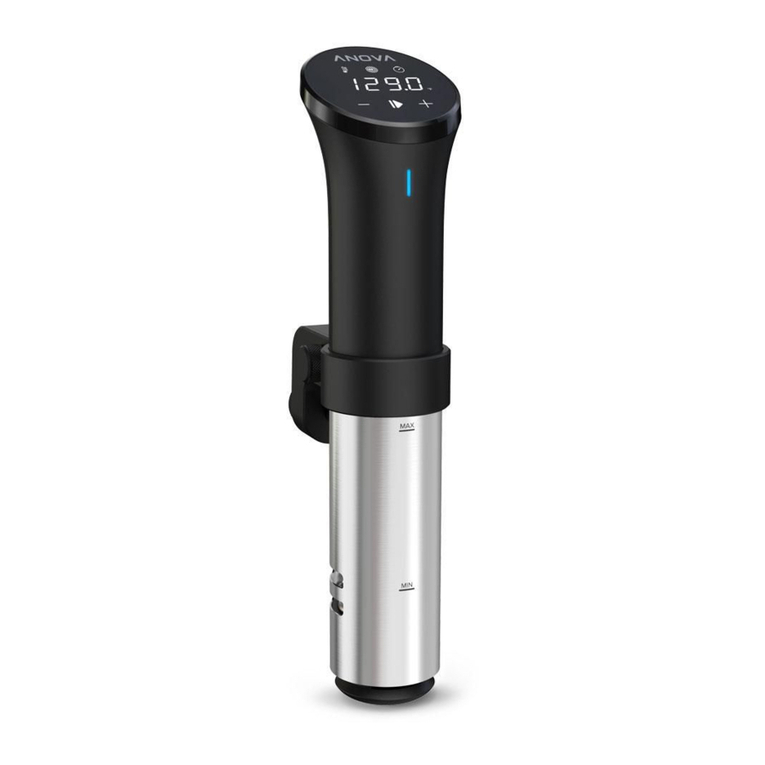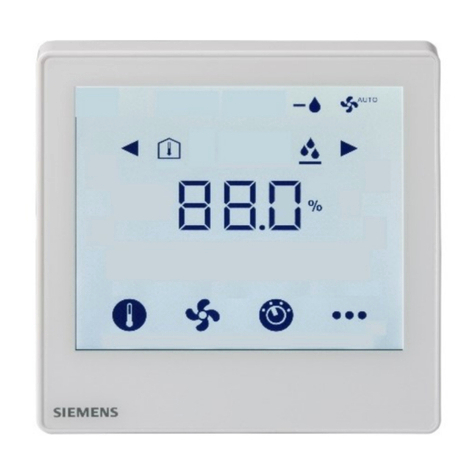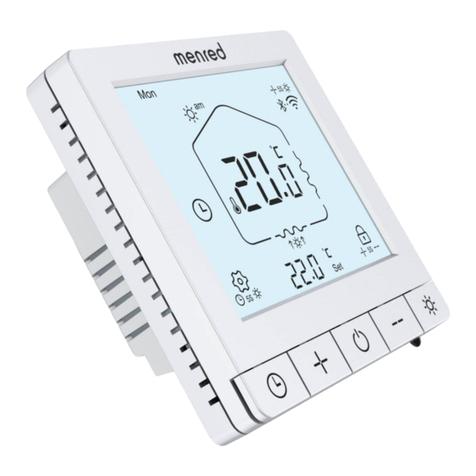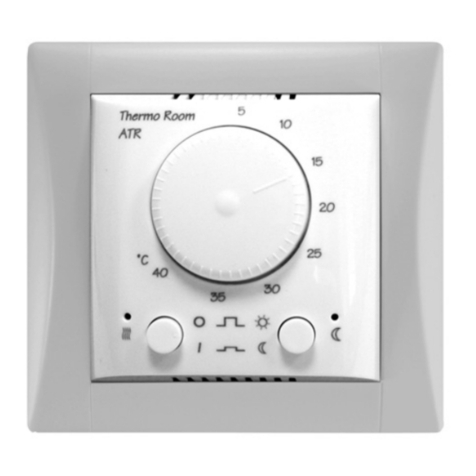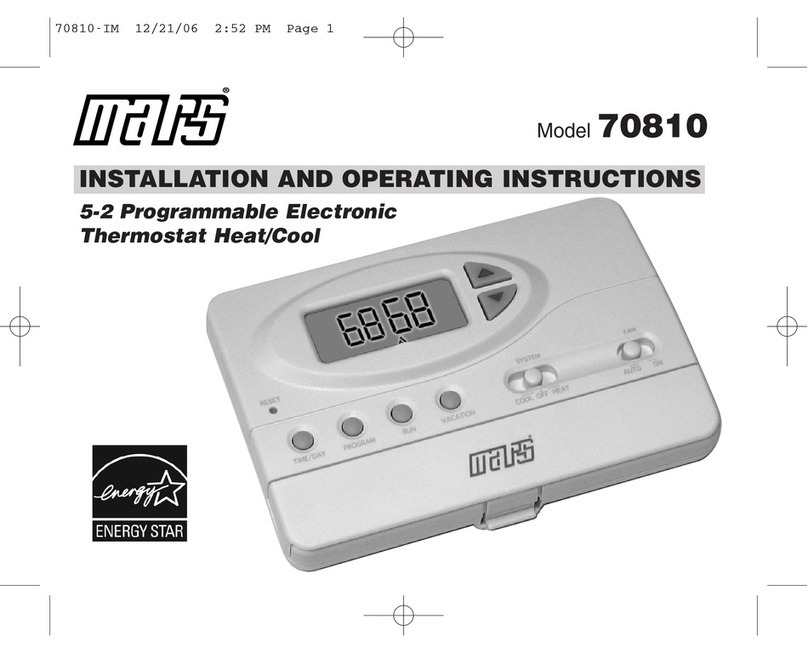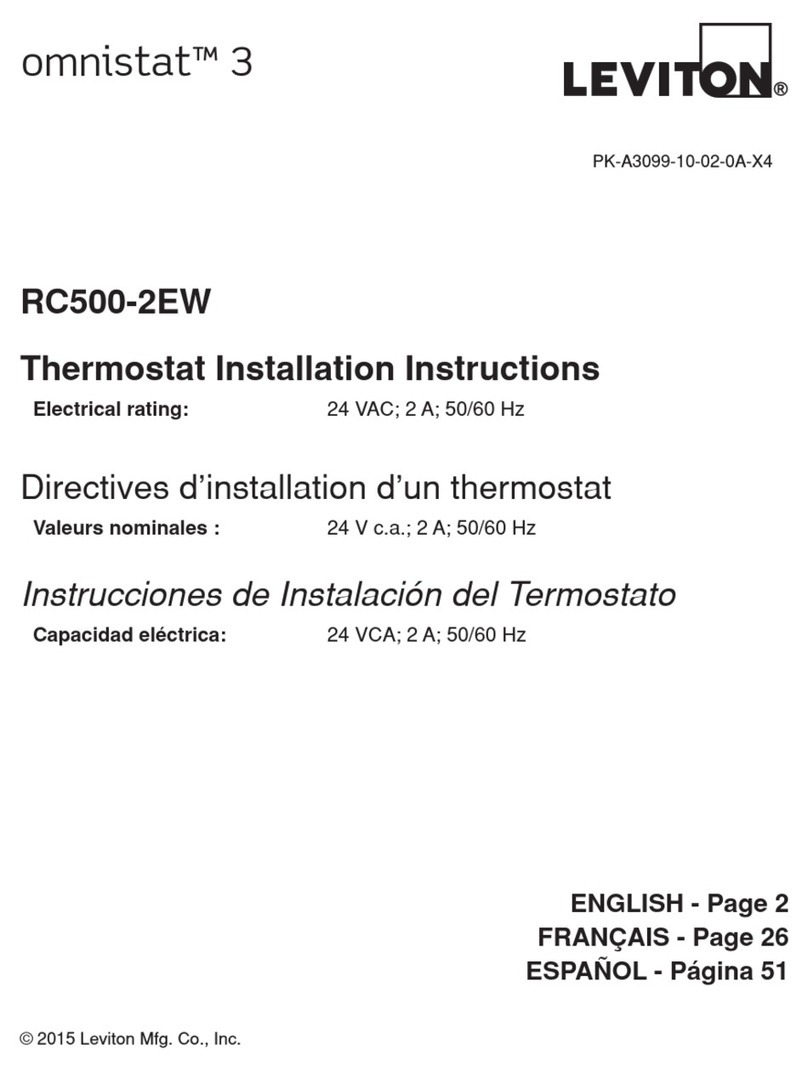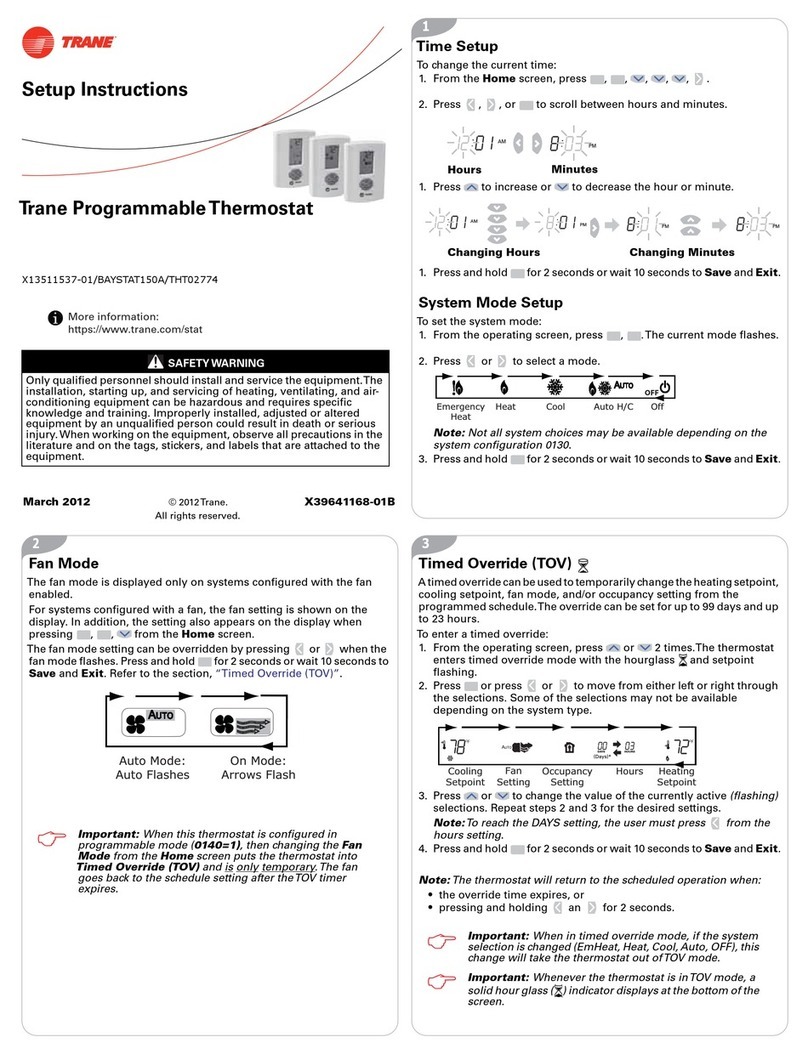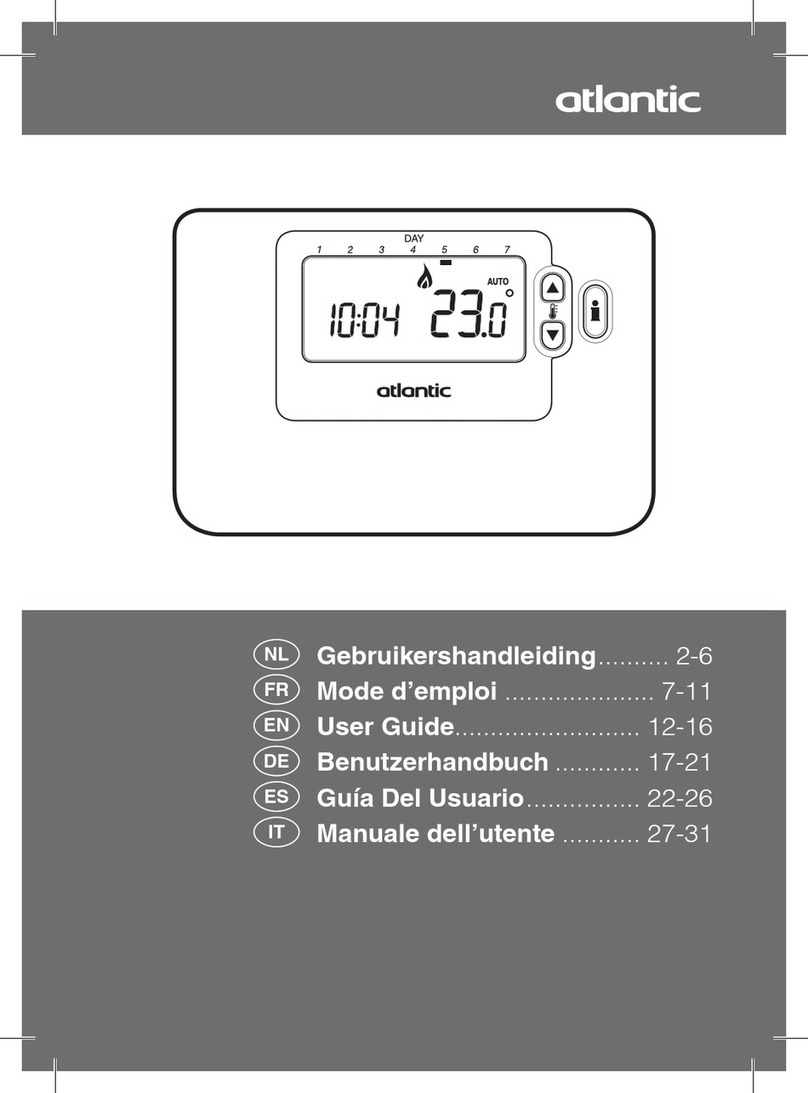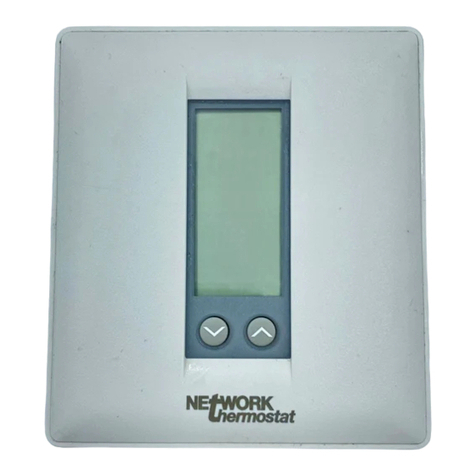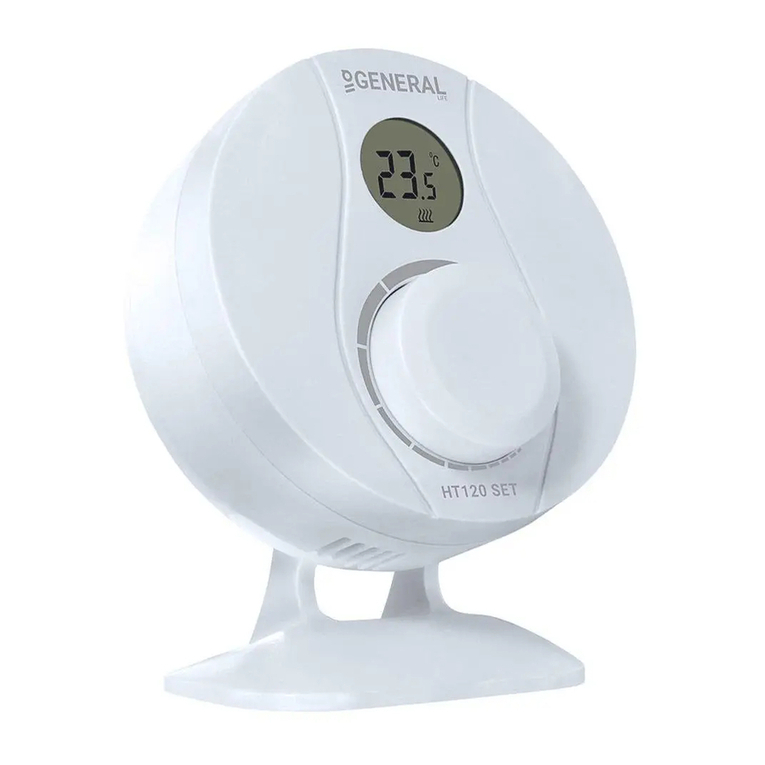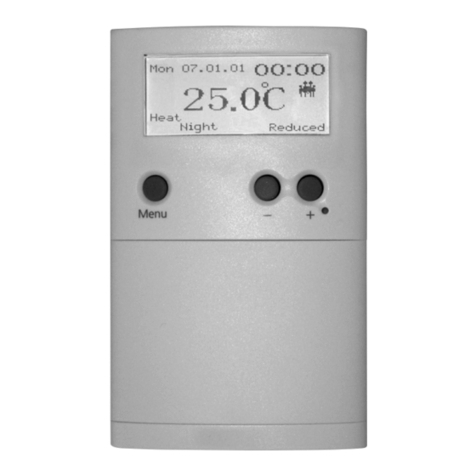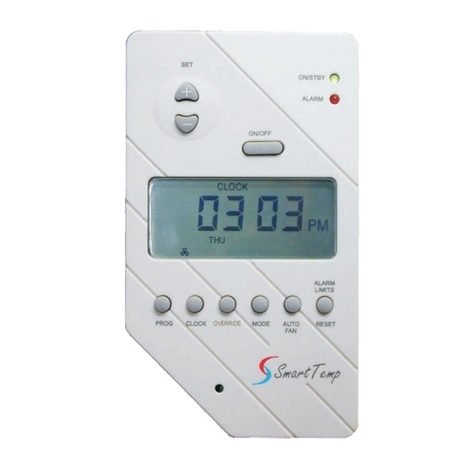Solid State Heating TSSHC-3DNPSB-16.7A User manual

INS-TSSHC-3DNPSB-16.7A-1209
User’s guide
For further information or to consult this guide on line,
please visit our Web site.
“TSSHC-3DNPSB-16.7A”
Electronic thermostat
www.sshcinc.com

INS-TSSHC-3DNPSB-16.7A-1209
2
WARNING
1.Description
The electronic thermostat TSSHC-3DNPSB-
16.7A is designed to control ENERJOY Radiant
Ceiling Panels, and electric resistance heaters,
including units with fans. Set point temperature
is accurately attained and maintained. The elec-
tric current design resistive load range extends
from 1.2A to 16.7A when operating at 120 to
240 Volts as explained in the detail that follows.
This thermostat is not compatible with the
following installations
•electrical current higher than 16.7 A with a
resistiveload(4000W@240VAC,3475W@
208VACand2000W@120VAC);
•electrical current lower than 1.2 A with a
resistive load (300 W @ 240 VAC, 260 W @
208VACand150W@120VAC);
•inductive load (presence of a contactor or a
relay);and
•centralheatingsystem.
Parts supplied :
•one(1)thermostat;
•two(2)mountingscrews;and
•two (2) solderless connectors suitable for
copperwires.
Before installing and operating this product,
the owner and/or installer must read, under-
stand and follow these instructions and keep
them handy for future reference. If these in-
structions are not followed, the warranty will
be considered null and void and the manu-
facturer deems no further responsibility for
this product. Moreover, the following in-
structions must be adhered to in order to
avoid personal injuries or property dam-
ages, serious injuries and potentially fa-
tal electric shocks. All electric connections
must be made by a qualied electrician,
according to the electrical and building
codes effective in your region. Do NOT con-
nect this product to a supply source other
than 120 VAC, 208 VAC or 240 VAC, and do
not exceed the load limits specied. Protect
the heating system with the appropriate cir-
cuit breaker or fuse. You must regularly clean
dirt accumulations on the thermostat. Do
NOT use uid to clean thermostat air vents.

INS-TSSHC-3DNPSB-16.7A-1209 3
aluminiumwires,youmustuseCO/ALRcon
nectors. Please note that thermostat does
nothavepolarity.
Two-wire installation
Four-wire installation
Installation work and electrical wiring
must be done by qualied person(s)
in accordance with all applicable
State/Country codes and standards.
2.Installation
Selection of thermostat location
The preferred thermostat location is on an in-
side wall four feet (1.2m) above the oor, in a
conveniently accessed locations such as next
to the light switch, and away from random tem-
perature impacts detailed in the examples that
follow.
Do not install the thermostat in a location
where temperature measurements could be
altered. For example :
•close to a window, on an external wall, or
closetoadoorleadingoutside;
•exposeddirectlytothelightorheatoftheSun,
alamp,afireplaceoranyotherheatsource;
•closeorinfrontofanairoutlet;
•closetoconcealedductsorachimney;and
•in a location with poor air flow (e.g. behind
a door), or with frequent air draft conditions
(e.g.headofstairs).
Thermostat mounting and connection
1. Cut off power supply on lead wires
at the electrical panel in order to
avoid any risk of electric shock.
2.Ensurethattheairventsofthethermostatare
cleanandclearofanyobstruction.
3.Maketherequiredconnectionsusingthefol
lowing figures by selecting the proper type
ofinstallation(2wiresor4wires),andusing
solderlessconnectors.Forconnectionswith

INS-TSSHC-3DNPSB-16.7A-1209
4
Installation work and electrical wiring must be done by qualied person(s) in
accordance with all applicable State/Country codes and standards.
4.Using a screwdriver, loosen the screw re
taining the mounting base and front part of
thethermostat.Removethefrontpartofthe
thermostatfronthemountingbasebytilting
itupward.
5.Align and secure the mounting base to the
connection box using the two screws sup
plied.
6.Reinstall the frontpartof thethermostaton
themountingbaseandtightenthescrewat
thebottomoftheunit.
7.Turnonthepower.
8.Setthethermostattothedesiredsetting(see
thefollowingsection).Important : you must
activate the Fan mode when the heating
unit is equipped with a fan; failure of the
heating unit could occur if not doing so.

INS-TSSHC-3DNPSB-16.7A-1209 5
3. Operation
+-
Ambient temperature /
Timer
Modes:
Frost free,
Day,
Night,
Fan,
Automatic
Heating
power
used
indicator
Temperature
set point
Button to decrease
set point / timer
Button to increase
set point / timer
Set point
lock

INS-TSSHC-3DNPSB-16.7A-1209
6
Ambient temperature
The figures displayed above the word “AMBI-
ENT” indicate the ambient temperature, ± 0.5
degree. Temperature can be displayed in de-
grees Fahrenheit or Celsius (see “Display in de-
grees Fahrenheit/Celsius”).
Temperature set point
The figures displayed above the word “SET” in-
dicate the temperature set point. It can be dis-
played in degrees Fahrenheit or Celsius (see
“Display in degrees Fahrenheit/Celsius”).
To adjust the set point, just
press down the right but-
ton to increase the value,
or the left button to de-
crease it. Set points can
be adjusted by increments
of 1°F or 0.5°C. To quick-
ly scroll through the set
point values, press and
hold down the button. The minimum set point is
37°F (3°C), and the maxi mum set point is 86°F
(30°C).
In Day mode, you can turn off the thermostat by
lowering the set point below 37°F. The set point
value displayed will be OFF, and heating system
start up will be impossible.
Day mode and Night mode
The thermostat includes a Day mode and a
Night mode, both of them having their own in-
dependently adjustable and recorded set point.
When switching from one mode to the other, the
system will automatically use the tempera ture
set point corresponding to the Day/Night mode
selected. The standard factory set point adjust-
ment is 68°F (20°C) for the Day mode, and 60°F
(16°C) for the Night mode.
The current Day/Night
mode selection is indi-
cated on the display by
the Sun or Moon icon. In
order to manually switch
from one mode to the oth-
er, simulta neously press
down the two buttons and
release them immediately.
Night mode timer
The Night mode features a timer that automati-
cally returns to the Day mode after a selectable
time period. This timer allows the temporary use
of a temperature set point. The standard factory
adjustment of the timer is 8 hours. With this ad-
justment, the thermostat automati cally returns
to Day mode 8 hours after being switched to
the Night mode.
For example, if you want a night temperature
lower than the day temperature, both Day/
Night modes set points will first have to be set
at the desired temperatures. Before bedtime,
the Night mode temperature set point will be
activated by switching manually to the Night
mode. The timer is set for the duration of the
night. The thermostat will automatically return
to the Day mode at the end of the night, and the
Day mode temperature set point, which is high-
er, will become effective at this time.
+-
+-
+-
+-

INS-TSSHC-3DNPSB-16.7A-1209 7
Night mode timer adjustment procedure
1.Ifnecessary,adjusttheDay/Nightmodeset
pointsatthedesiredtemperatures.Ifneed
ed,switchfromonemodetotheotherbysi
multaneouslypressingdownthetwobuttons
andreleasingthemimmediately.
2.FromtheNightmode,simultaneouslypress
downthetwobuttonsformorethan3sec
onds until the icon SET starts to blink, in
dicating that the adjustment of the Night
modetimeriseffective.Thefiguresdisplayed
abovetheword“AMBIENT”indicatethecur
rentadjustmentofthetimer.
3.Ifneeded,adjustthetimerbypressingdown
therightbuttontoincreasethevalue,orthe
left button to decrease it. The adjustment
rangeisfrom1hourto999hours.Toquickly
scroll through timer values, press and hold
downthebutton.
4.When the adjustment is completed, release
thebuttonsandwaitfor5secondstoexitthe
adjustmentfunction.
NB: The Night mode timer will be auto matically
reinitialized to the latest re corded value when
switching from the Day mode to the Night
mode. It is not necessary to readjust the timer
every time you switch to the Night mode. The
timer is also reinitialized when this value is
adjusted.
Once the timer has completed its cycle and
when the thermostat is in the Day mode, you
must manually return to the Night mode. If you
want to automatically return to the Night mode,
the Automatic mode must be selected
Automatic mode
The Automatic mode, which is associated to
the Night mode timer, allows alternating be-
tween the Day/Night modes and the two cor-
responding set points over a 24-hour period.
Once activated, this mode allows an automat-
ic return to the Night mode after 24 hours. The
Automatic mode allows you to define two peri-
ods in a single day with different set points.
For example, if the Automatic mode is activated
and the Night mode timer is set at 8 hours, the
thermostat will be operating in the Night mode
for 8 hours at the night temperature set point.
Then, it will return to the Day mode for 16 hours
operating at the day temperature set point. At
the end of the 24-hour cycle, the thermostat will
return to the Night mode, and the cycle will start
again.
The 24-hour cycle starts with the Night mode as
soon as the Automatic mode is activated. The
Automatic mode activation should be made
when you want to return to the Night mode. The
normal course of a cycle in the Au tomatic mode
is as follows:
1Nightmode:activatedforthedurationofthe
Nightmodetimercycle.ItreturnstotheDay
modewhenthetimercycleiscompleted.
2Daymode:activatedfortheremainingtime
ofthe24hourcycle.It returns totheNight
modeattheendofthe24hourcycle.

INS-TSSHC-3DNPSB-16.7A-1209
8
Adjustment procedure of the Automatic mode:
1.Ifnecessary,adjusttheDay/Nightsetpointat
the desired temperatures.If needed,switch
from one mode to the other by simultane
ously pressing down the two buttons and
releasingthemimmediately.
2.FromtheNightmode,simultaneouslypress
downthetwobuttonsformorethan3sec
onds, until the icon SET starts to blink, in
dicating that the adjustment of the Night
modetimeriseffective.Thefiguresdisplayed
abovetheword“AMBIENT”indicatethecur
renttimeradjustment.
If needed, adjust the timer by pressing down
the right button to increase the value, or the
left button to decrease it. The Night mode
timer adjustment range is from 1 hour to
23 hours in the Automatic mode. To quickly
scroll through the timer values, press and
hold down the button. NOTE: If you set the
timer to any value exceeding 23 hours, it
will be impossible to activate the Automatic
mode and if it was activated, the Automatic
mode will be deactivated.
3.Activate the Automatic mode by simultane
ously pressing downthe two buttonsforat
least 3 seconds. The Automatic mode icon
will appear. If the Automatic mode was al
readyactivated,thesameprocedureshould
beusedtodeactivateit.
4.When the adjustment is completed, release
thebuttonsandwaitfor5secondstoexitthe
adjustmentfunction.
NOTE : It is always possible to manually
change the Day/Night mode during a 24-hour
cycle. However, any manual return to the Night
mode will re-initialize the Night mode timer to
the latest value recorded, which modifies the
cycle in progress. In all cases, at the end of
the 24-hour cycle, the thermostat will return
to the Night mode and start a new cycle. It is
thus not necessary to readjust the Automatic
mode when a manual change is made to the
Day/Night mode.

INS-TSSHC-3DNPSB-16.7A-1209 9
Frost-free warning
The Snowake icon is displayed when the tem-
perature set point is between 37°F (3°C) and
41°F (5°C). A minimum temperature will be
maintained to ensure frost control.
Display in degrees Fahrenheit/Celsius
The thermostat can display the ambient tem-
perature and the set point in degrees Fahrenheit
(standard factory setting) or Celsius.
Selection procedure for degree Fahrenheit/
Celsius display
1.From the Day mode, simultaneously press
down the + and – buttons for more than 3
secondsuntiltheSETiconstartstoblink..
2.Pressdownthe+buttontoswitchfromthe
degrees Fahrenheit to the degrees Celsius,
and conversely. The degree Fahrenheit or
Celsiussymbolwillbedisplayed.
3.When the adjustment is completed, release
thebuttonsandwaitfor5secondstoexitthe
adjustmentfunction.
Fan mode
When the thermostat is used to control a heat-
ing system equipped with a fan, the Fan mode
MUST be activated. This mode prevents the
system from continuously starting and stoping,
which could cause fan failure. The Fan mode is
by default deactivated at the factory. The sta-
tus of this mode is indicated on the display by
the Fan icon.
Adjustment procedure for the Fan mode
1.From the Day mode, simultaneously press
down the + and – buttons for more than 3
seconds,untiltheSETiconstartstoblink.
2.Press down the – button to activate or de
activatetheFanmode.TheFaniconwillbe
displayedornot,asapplicable.
3.When the adjustment is completed,
releasethebuttonsandwaitfor5secondsto
exittheadjustmentfunction.

INS-TSSHC-3DNPSB-16.7A-1209
10
Lock option
It is possible to impose a maximum tempera-
ture set point by activating this mode. Then, it
becomes impossible to exceed this set point,
regardless of the mode. However, it is still pos-
sible to lower the set point at your discretion.
Locking procedure
1.FromtheDaymode,adjustthesetpointat
themaximumdesiredvalue.
2.From the Day mode, simultaneously press
downthe+and–buttonsformorethan10
seconds, until the Lock icon displays (note
thattheSETiconwillalsoblinkafter3sec
onds).
3.Releasethebuttons.Thethermostatisnow
locked.
Unlocking procedure
1.Cutoffthepowersupplyofthethermostatat
theelectricalpanel.
2.Waitatleast20seconds.
3.Restorethepowersupplyofthethermostat
attheelectricalpanel.
4.TheLockiconisblinkingonthethermostat
display,meaningthatitispossibletounlock
thethermostat.
5.While the Lock icon is blinking, simultane
ously press down the + and – buttons for
more than 10 seconds, until the Lock icon
disappears.
6.Releasethebuttons.Thethermostatisnow
unlocked.
NOTE: If the thermostat isn’t unlocked within 5
minutes after the restoration of the power sup-
ply, the Lock icon will stop to blink and it will be
impossible to unlock the thermostat unless cut-
ting off the power supply again.
Heating power indicator
The level of power used to maintain the tem-
perature at the set point is expressed as a per-
centage indicated by the number of bars in the
thermometer displayed. The heating power
used is displayed as follows:
0 bar = no heat
1 bar = 1% to 25%
2 bars = 25% to 50%
3 bars = 50% to 75%
4 bars = 75% to 100%
Power failure
In the case of a power failure, the adjustments
are automatically saved and recovered when
power is restored. Note that the Day/Night
mode is recovered only if the Automatic mode
was previously deactivated. Otherwise, the
thermostat comes back in Day mode and the
Automatic mode icon blinks, meaning that the
Automatic mode was previously activated and
that it is now deactivated. Blinking will stop as
soon as a button is pressed down.

INS-TSSHC-3DNPSB-16.7A-1209 11
4. Troubleshooting
Problem Description Solution
1 The thermostat is hot.
Innormaloperatingconditions,thethermostathousingcanreach
nearly104°F(40°C)atmaximumload.Thatisnormalandwillnot
affecttheeffectiveoperationofthethermostat.
2 Heating is always on. Checktobesurethatthethermostatisproperlyconnected.Refer
totheinstallationsection.
3
Heating does not run
even if the thermostat
indicates it is on.
Checkifthethermostatisproperlyconnected.Refertothe
installationsection.
4The display does not
come on.
Checkifthethermostatisproperlyconnected.Refertothe
installationsection.Checkthepowersupplyattheelectrical
panel.Checkiftheheatingunithasaswitch.Ifso,checkthe
circuitbreakerandinterveningswitchesperformance.
5
The display turns off a
few minutes and then
turns on again.
Thethermalprotectionoftheheatingunithasdeactivatedtheunit
duetooverheating.Checkiftheheatingunitisingoodcondition
ofoperationandthatclearancearoundtheapplianceisaccording
tothemanufacturer’sspecifications.
6
The display has low
contrast
when heating is on.
Theloadislowerthantheminimumload.Installaheatingunitthat
iswithintheloadlimitsofthethermostat.
7
The displayed ambient
temperature is
incorrect.
Checkthepresenceofanairstreamoraheatsourcenearthe
thermostat,andcorrectthesituation.Notethatthethermostat
measuresdrybulbairtemperatureatthelocationofthe
thermostat.
8The display indicates
E1 or E2. Faultythermalsensor.Contactcustomerservice.
9Weak luminosity of the
display.
Possibilityofabadcontact.Checkthermostatwirings.Referto
theinstallationsection.

INS-TSSHC-3DNPSB-16.7A-1209
12
5. Technical specications
Supply voltage:
120/208/240 VAC, 50/60 Hz
Minimum electrical current with a resistive load:
1.2 A
300 W to 240 VAC
260 W to 208 VAC
150 W to 120 VAC
Maximum electrical current with a resistive load:
16.7 A
4000 W to 240 VAC
3475 W to 208 VAC
2000 W to 120 VAC
Temperature diplay range:
32 °F to 99.5°F (0 °C to 40°C)
Temperature display resolution:
0.5 °F (0.5 °C)
Temperature set point range:
37 °F to 86°F (3 °C to 30°C)
Temperature set point increments:
1 °F (0.5 °C)
Storage temperature:
-4 °F to 120 °F (-20 °C to 50 °C)
Certication:
Limited Warranty
This unit has a 3-years warranty. If at
any time during this period the unit be-
comes defective, it must be returned to
its place of purchase with the invoice
copy, or simply contact our customer
service department (with a copy of the
invoice in hand). In order for the warran-
ty to be valid, the unit must have been
installed and used according to instruc-
tions. If the installer or the user modifies
the unit, he will be held responsible for
any damage resulting from this modi-
fication. The warranty is limited to the
factory repair or the replacement of the
unit, and does not cover the cost of dis-
connection, transport, and installation.
Customerservice
SSHC, Inc.
P.O. Box 769
Old Saybrook, CT 06475
(860) 399-5434
www.sshcinc.com
Table of contents
